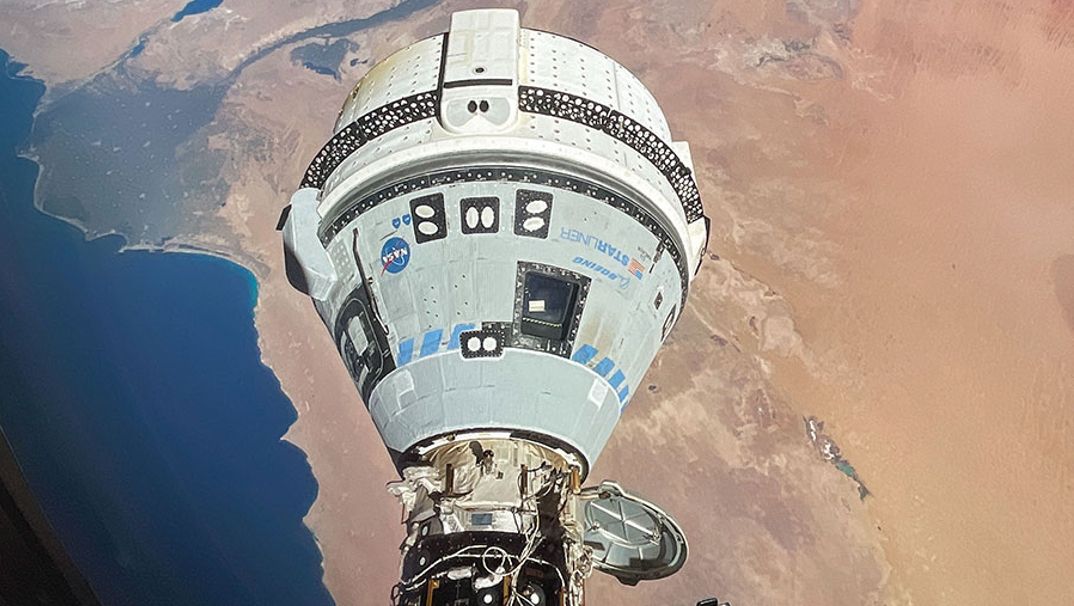Boeing’s Starliner capsule is performing well enough on its first astronaut mission that it will likely be able to stay in orbit beyond the originally anticipated 45-day limit, NASA says.
Starliner, which launched on June 5, is docked at the International Space Station (ISS) with an indefinite mission extension. The spacecraft is in good condition and rated to leave the ISS in the event of an emergency. But both NASA and Boeing are trying to figure out why some of the Starliner’s reaction control system (RCS) thrusters experienced problems in the direction of docking with the ISS on June 6, and why some helium leaks have appeared in the capsule. As such, Starliner will remain in space until at least later this summer while testing and analysis continues. For example, a new round of propellant field tests will begin soon, possibly as early as today (July 2).
On-orbit testing on June 15 was unable to find the root cause of the issues, although agency officials noted on Friday (June 28) that progress had been made: helium leaks have been stabilized and all but one of the faulty propellants has been assessed to use to return to Earth. (The Starliner has a total of 28 thrusters in its RCS; five were misbehaving, and of those five, only one will be taken offline during the shutdown.)
Since the RCS is in the Starliner’s service module, which will be jettisoned before entry, descent and landing, the extra time in orbit will allow the teams to take their time figuring out how to proceed. That will be essential for any service module design changes that will be needed for the next six-month ISS spin missions that Starliner flies in 2025. But to give ground crews time for testing, NASA says that the Starliner must remain docked for more than 45 days, which was the initial outer limit for this mission. The good news is that the spacecraft looks good to go for perhaps twice that time — or more.
Connected: Propeller malfunctions and helium leaks can’t stop Boeing’s Starliner astronaut test flight — but why are they happening?
“We talked about a 45-day limit, limited by the crew module batteries on the Starliner, and we’re in the process of updating that limit,” Steve Stich, manager of NASA’s Commercial Crew Program, told reporters during the teleconference. of Friday.
“We’ve looked at those batteries and their performance in orbit. They’re being recharged from the station and that risk hasn’t really changed. So the risk for the next 45 days is basically the same as the first 45 days,” he said.
Starliner, in fact, is estimated to stay up to 210 days in orbit once operational missions begin, he noted. But since this is only Starliner’s third mission in space, and the first with astronauts, NASA had not been sure of the battery’s performance in orbit before.
When Space.com asked how long the mission might last, Stich said, “We haven’t decided yet how long we’re going to take it.” The Starliner has 12 different batteries, he explained. Before this flight, similar batteries sat on the ground for a year and were then tested to make sure there were no defects, and none were found.
“What we’re really doing now is looking at battery performance in flight. We don’t see any degradation in any of the cells where the batteries are,” he added.

The current Starliner mission, called the Crew Flight Test (CFT), was originally intended to last about 10 days. It features two NASA astronauts: Butch Wilmore and Suni Williams. Both are former US Navy test pilots with decades of experience working on development missions like this space flight.
Wilmore told Space.com on May 1, before launch, that the Navy provided the astronauts with critical skills for CFT, such as testing how systems work together. “Well, gosh, that’s really why we’re here,” he said, reflecting on the duo’s thousands of hours of piloting experience. Later, he added that their experience has been “invaluable to the process” in working on the Starliner.
CFT was meant to examine contingencies in space and has built-in flexibility in terms of planning. Additional ground testing will be conducted at the White Sands test facility in New Mexico to attempt to duplicate how the RCS thrusters are used in flight and especially during docking. (NASA abandoned the first docking attempt on June 6, but authorized the second a few hours later.)
Meanwhile, Williams and Wilmore are supporting the ISS astronauts on other tasks while they await the results of the White Sands test, which will last no less than two weeks. Recent NASA blog posts have detailed the work of CFT astronauts maintaining the ISS: orbital plumbing for a few days, then more recently organizing items in the Multipurpose Permanent Module.
Williams and Wilmore also worked on the Japan Experiment Module on Monday (July 1) “to dismantle an empty NanoRacks CubeSat hub in preparation for future NanoRacks missions,” NASA officials wrote Monday (July 1).
The first two Starliner space missions saw no crew. The first, in December 2019, failed to reach the ISS due to computer glitches that stuck it in the wrong orbit. The second, in May 2022, reached the ISS safely after Boeing made dozens of adjustments, but the Starliner’s thrusters suffered some problems; this is another reason NASA and Boeing are taking their time with CFT’s return to see why the spacecraft’s thrusters misbehaved in both 2022 and 2024.
Boeing is one of two suppliers for ISS astronaut missions, the other being SpaceX. Elon Musk’s company uses its Crew Dragon capsule, which is based on SpaceX’s Dragon cargo vehicle. Crew Dragon had a faster path to orbit: an uncrewed mission in 2019, followed by an astronaut flight test in 2020. Dragon has sent 11 crews to the ISS since then, most of them on six-month operational orbiting missions. crew for NASA.